|
|
Click on pictures to enlarge them.
|
|

|
These pictures are brought to you in association with Itronix
|
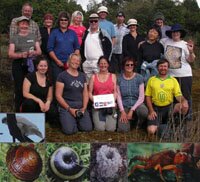
|
The Blue Tier Highlands: Tasmania North-East hidden treasure !
Friends of the Blue Tier promote and organise short or longer walks to raise awareness about this extraordinary but endangered forest area.
Recognised as glacial refugium, where unique animal and vegetal species survived the last glacial age, the Blue Tier is exceptional in that it is both hot and cold refugia.
It is home to dozens of unique birds, including the pure white "grey goshawk" raptor. It also hosts Blue Tier endemic species such as the state's largest snail, the bronze shelled anoglypta, which can live up to 20 years !
One of the most surprising local wildlife for us is a cousin of the giant eastern freshwater lobster: the mud chimney-builder crayfish! Engaeus is also referred to as the burrowing crayfish, as it digs on land tunnels ranging from simple vertical shafts to complex interconnecting underground chambers.
These endemic species, along with beetles, worms or mammals, thrive amongst a variety of vegetals and cryptogams which extend from rainforest pockets in the gullies to the lichen-carpeted mountain summits.
Only a very small fraction of the Blue Tier is currently protected. The rest is threatened to be completely clearfelled and replaced by commercial tree plantations. The idea would be to produce good old wood chipping and pulp with, believe it or not, the incredible ambition of competing with worldwide giants from Finland, Canada, Sweden or China.
Why this sudden attempt to turn Tasmania into an industrial powerhouse, which is likely to fail in the eye of international competition? The question should be what has Tasmania got to offer that no other land could match?
The flourishing and job creating tourist industry in Tasmania already proves that pristine nature has a market value. So why destroy one's best assets?
Or write to:
|
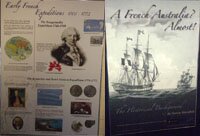
|
A French Australia? Almost!
This is the theme of an exhibition displayed in Albany, Western Australia. It tells the story of the numerous expeditions conducted by French explorers between the 16th and 19th centuries which account for more than 400 French names still placed today on various parts of the Australian coast.
The French had considered plans for settlements on the south coast of Western Australia but it seems that their main focus was scientific. The French missed their final opportunity to form a colony on this continent when the brig Amity sailed from New South Wales and established a settlement in present-day Albany.
This exhibition displays material provided by historian Noelene Bloomfield from her book which bears the same title.
|
|
|
|
|

|
United Arab Emirates, Dubai. Dubai, with its expats, its fast pace and its wide choice of fast-food restaurants is quickly losing its culinary tradition. This is also true for the 10% of local families whose everyday meals are prepared by housemaids coming from the Indian sub-continent or from the Philippines.
At "Cooking Sense", located in Dubai Media City, Samira teaches regional recipes which she has been lovingly conserving, as a curator would with works of art.
Her classes mainly attract expats interested in traditional cuisine and lifestyle. But local young ladies trying to recapture some of their culinary traditions and roots also come to her.
Samira, who grew up in Damascus, has put her credibility to test during her 'mere' 10 years spent in Dubai. And her culinary expertise runs far beyond the Emirates: some of her recipes were for instance passed on to her by her Omani mother-in-law.
What a delightful place, very modern yet very warm and welcoming, where each cooking lesson is followed by a delicious dinner party! An initiative which is both useful and fun, don't you think?
www.cooking-sense.com
|
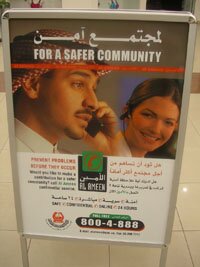
|
United Arab Emirates. Close to Dubai we saw this poster at the "Dragon Mart" which is dedicated to products made in China. This campaign "For a safer community" guarantees confidentiality to those willing to report a potential problem. A toll free number is provided. We can only hope that the callers' motivation will always be a positive one.
|
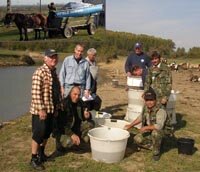
|
Northwestern Romania. Environmental project: a fishing club from the Netherlands lends a hand to a Roumanian counterpart to help revitalize a local river. The Dutch team came for a week, bringing along its equipment in order to conduct an "electrical fishing session". Fish are thus caught, measured and counted. This inventory is a first step, to be followed by recommendations and an action plan defined with the Roumanian team, with the objective of giving new life to their local river.
|
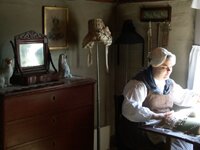
|
Travel through time in Turku, South-West of Finland. During one week in August, handicrafts from the past are demonstrated in the open air museum Luostarinmäki, in their original neighborhood. This is a real lacemaker live from the old days, her fingers moving so fast that they are difficult to follow.
|
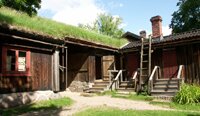
|
Luostarinmäki, a neighborhood of wooden houses dating from end of 18th to early 19th century was then the handicraft neighborhood, located on a hill of Turku, in Finland. This district was spared by the great fire of 1827, and has housed the handicrafts works of the Museum of History since 1938. Today, over 50 restored houses are a living testimony to the old lifestyle and handcrafts attached to it : coppersmith's, furrier's, saddlemaker's, gilder's and frame-maker's, combmaker's, carriagemaker's, cordmaker's, and many others.
|
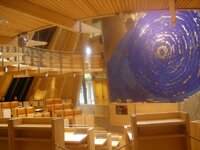
|
The inside of the Sami Parliament in Karashok, in Arctic Norway, is a showcase of local materials, traditionally used in housing: wood, reindeer skin, stone. The shape of the building was inspired by traditional Sami housing, such as the làvvu, a teepee-shaped tent. The firepit, composed of 7 stones, one for each day of the week, is here symbolized by the central panel, which also recalls a view of the world, seen from the pole.
|

|
The Sàmediggi, the Sami Parliament for Norway, was established in Karashok in 1989. It has 39 members elected for 4 years directly by the people. Their role is to defend the interests of the Sami community in Norway, including the Finnish and Swedish Sami residing in Norway.
|
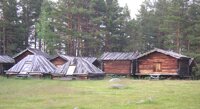
|
The Sami are the only indigenous people in Europe: they have been living in Arctic Europe for over 10 000 years! In northern Sweden, in Arvidjaur, the open air museum presents traditional housing. They are an interesting introduction to Sami lifestyle, prior to visiting Jokkmokk, further north beyond the Arctic circle, with its Ajtte Museum dedicated to Sami culture.
|
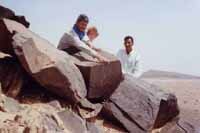
|
5,000 years ago man carved petroglyphs of local fauna - here a bustard, a bird of the crane family - which disappeared from the area when it turned into the Sahara desert.Local guide Hassan participated in a recent effort to index the region's petroglyphs, hoping it would contribute to saving them, as erosion but also pure looting have been threatening these fragile treasures. Please don't buy any if you are offered to. Foum El Hassn, South Morocco
|
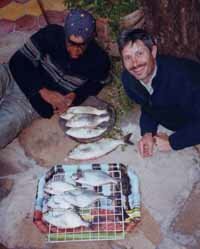
|
First time I ever used this amazing bait: sea weeds! Thanks to the advice of my improvised "fishing guide", Abdu, I caught my biggest goldline, a two kilo (4 lb.) ("sarpa" in Latin). This youngster not only loves to fish but would also gladly contribute to feeding his family, if only he owned a fishing pole... which he finally did when we left, as a sign of my appreciation. Tasra Inn, Imsouane, Moroccan Atlantic coast, one hour north of Agadir
|
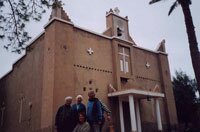
|
Three of the four Franciscan sisters based in Ouarzazate. Their action includes a school for the hearing impaired, a dispensary and covers a territory of 200 x 300 km (24 000 sq mi). They speak fluent Arabic and Berber which they can also write! They did dispatch wisely our 100 kg load of clothes, pens, medicine, toys. If you think you can carry a few extra kilos, please take the time to drop some useful items at Sainte Thérèse Church, Ouarzazate, Morocco!
|
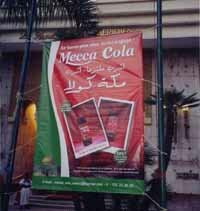
|
Launch of an ad campaign for Mecca Cola: "United we stand for dignity", as some of their profits go to children's charities "10% in Palestine, 10% in Morocco". Feb. 2002, Casablanca, Morocco.
|
|

